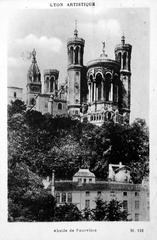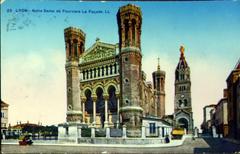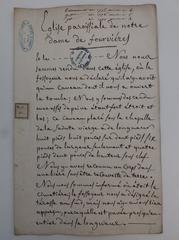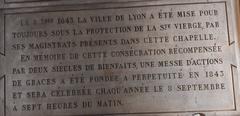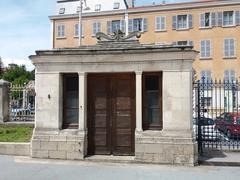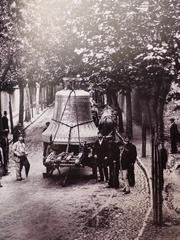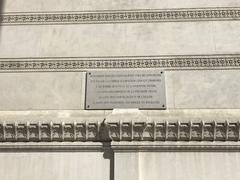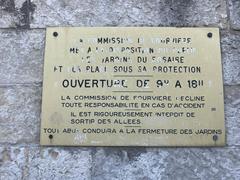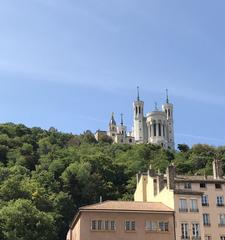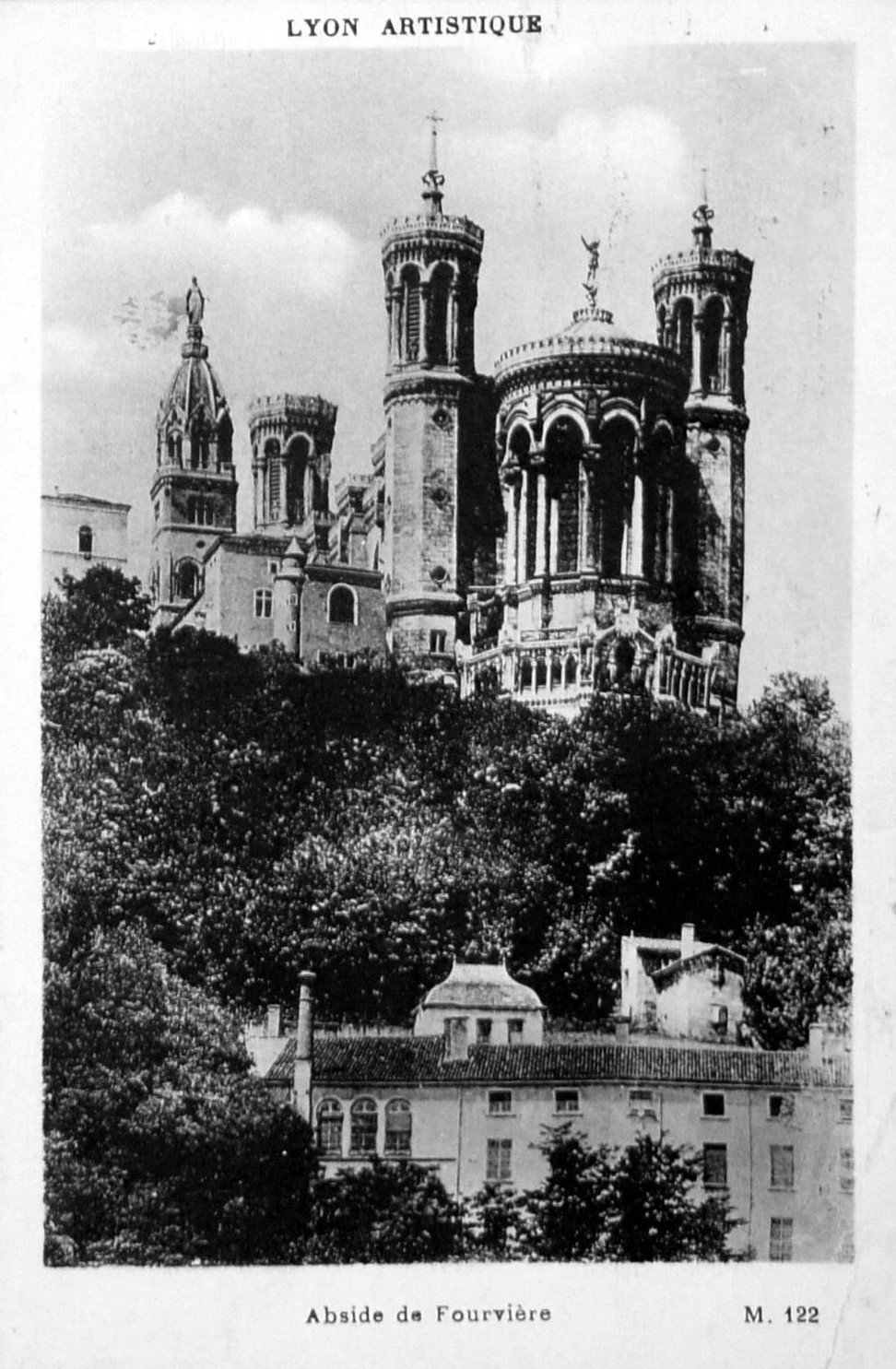
Basilica of Notre-Dame de Fourvière Lyon: Visiting Hours, Tickets & Historical Sites Guide
Date: 14/06/2025
Introduction
Perched atop Fourvière Hill, the Basilica of Notre-Dame de Fourvière stands as one of Lyon’s most iconic landmarks. Blending centuries of history, architectural grandeur, and profound spiritual significance, the basilica is a testament to Lyon’s resilience and cultural identity. Drawing millions of visitors annually, it represents not only Marian devotion dating back to the Middle Ages but also commemorates the city’s endurance through plagues, wars, and social upheavals. Its roots stretch back to the Roman era of Lugdunum, evolving through Christian martyrdom and medieval chapels, and culminating in the 19th-century basilica we see today (Xixerone; Two in France; Google Arts & Culture).
This guide details the basilica’s history, architecture, visiting hours, tickets, accessibility, nearby attractions, and practical tips for a memorable visit.
Table of Contents
- Introduction
- Ancient and Early Christian Roots
- Medieval Chapels and Marian Devotion
- 19th-Century Vows and Construction
- Architectural Style and Features
- Symbolism and Cultural Impact
- Visiting Information (Hours, Tickets, Accessibility)
- What to See and Do
- Getting There and Facilities
- Best Times to Visit
- Dress Code and Etiquette
- Safety and Tips
- Where to Stay
- FAQ
- Conclusion
- References
Ancient and Early Christian Roots
Fourvière Hill has served as a spiritual center for Lyon since Roman times. Its name comes from “Forum Vetus” (Old Forum), the site of the Roman forum of Trajan when Lugdunum (modern Lyon) was founded in 43 BCE (Wikipedia; Xixerone). Archaeological remnants, such as the Gallo-Roman Theatre and its museum, bear witness to the site’s ancient importance.
Christianity flourished here in the 2nd century CE, with Saint Pothinus, Lyon’s first bishop, martyred on this very hill—a legacy that established Fourvière as a place of Christian worship (Xixerone).
Medieval Chapels and Marian Devotion
In 1174, a chapel dedicated to the Virgin Mary was erected by Olivier de Chavannes, soon joined by a chapel for Saint Thomas Becket (VisitOnLyon). Despite destruction during the 1562 Wars of Religion, the sanctuary was rebuilt by the late 16th century.
During the 1643 plague, Lyon’s leaders vowed to honor Mary if spared, building a new chapel that inspired the annual Fête des Lumières (Festival of Lights) on December 8th—a tradition that remains central to Lyon’s cultural calendar (RoamingXplorer; ThisIsLyon).
19th-Century Vows and Construction
Moments of crisis continued to reinforce Lyon’s Marian devotion. In the 1832 cholera epidemic and the 1870 Franco-Prussian War, citizens once again vowed to build a grand basilica for Mary’s protection. Construction began in 1872 and was completed in 1884, with final details added by 1896 (RoamingXplorer; Google Arts & Culture; ThisIsLyon).
Architectural Style and Features
Designed by Pierre Bossan, the basilica is an eclectic masterpiece, combining Romanesque, Byzantine, and Gothic elements—a bold departure from the Gothic revival trend of its era (Catholic Shrine Basilica). Its white limestone façade, four 48-meter towers (representing the cardinal virtues), and a prominent gilded statue of the Virgin Mary define its exterior. The interior is equally remarkable, with blue marble columns, intricate gold mosaics, and stained-glass windows illustrating Lyon’s spiritual history (VisitOnLyon).
The crypt, dedicated to Saint Joseph, offers a quieter, more solemn space, while the basilica’s two superimposed churches showcase Bossan’s architectural ambition (RoamingXplorer; Catholic Shrine Basilica).
Symbolism and Cultural Impact
The basilica’s style and grandeur stirred controversy upon completion, with some viewing it as politically reactionary. However, it quickly became a symbol of Lyon’s resilience and faith, and today stands at the heart of the city’s UNESCO World Heritage center (HistoryTools). The annual Festival of Lights transforms its façade into a canvas of illumination, attracting millions (ThisIsLyon).
Ongoing restoration efforts highlight Lyon’s commitment to preserving this heritage for future generations.
Visiting Information
Visiting Hours
- Basilica: Daily, 8:00 AM – 7:00 PM (hours may vary on holidays; check the official site before visiting).
- Sanctuary Gates: Open 7:00 AM – 11:00 PM.
Tickets
- Entry: Free to the basilica and main sanctuary.
- Observation Tower & Guided Tours: €5–€7, bookable on-site or online. Advance booking is recommended during busy seasons (Nomads Travel Guide; TripHobo).
Accessibility
- Wheelchair Access: Most main areas accessible via ramps and elevators. Some areas like the tower require stair climbing.
- Audio Guides: Available in multiple languages.
- Assistance: Provided for visitors with disabilities; check the basilica’s website for details.
What to See and Do
Basilica Interior
- Upper Church: Adorned with golden mosaics, blue marble columns, ornate ceilings, and the iconic Golden Virgin statue (TripHobo).
- Crypt of Saint Joseph: Quieter, contemplative, and adorned with commemorative marble plaques (Catholic Shrine Basilica).
Panoramic Terrace
- Offers some of Lyon’s best views—ideal for photos, especially in the morning or late afternoon (Nomads Travel Guide).
Observatory Tower
- Climb 287 steps for a 360° view over Lyon and, on clear days, the Alps. (Ticket required; not accessible for those with mobility challenges.)
Gardens and Surroundings
- Jardin du Rosaire: Terraced gardens with statues, fountains, and shaded benches for relaxation (Nomads Travel Guide).
Nearby Attractions
- Roman Theatres of Fourvière: Ancient ruins from Lyon’s Roman era.
- Vieux Lyon: Renaissance old town and UNESCO World Heritage site, easily reachable by foot or funicular (Nomads Travel Guide).
Getting There and Facilities
- Funicular Railway: From Vieux Lyon/Saint-Jean metro station, direct to Fourvière. Tickets purchasable at the station; included in public transport network.
- On Foot: Scenic climb through Rosaire Gardens takes 20–30 minutes.
- By Car/Taxi: Parking limited; public transport is advised.
Facilities:
- Restrooms on-site.
- Gift shop with religious and local souvenirs.
- Cafés and snack bars nearby.
- Multilingual guided tours.
- Accessibility features for main areas.
Best Times to Visit
- Avoid Crowds: Early mornings and weekdays are quieter. Peak times are weekends, religious holidays, and afternoons (2:00–3:00 PM).
- Duration: Average visit lasts 1.5 hours (TripHobo).
Dress Code and Etiquette
- Dress modestly—cover shoulders and knees, remove hats inside.
- Maintain silence, especially during services and in the crypt.
- Photography is allowed without flash/tripods; check signage.
Safety and Tips
- The basilica is well-patrolled and safe. Pickpocketing can occur in crowded areas—keep valuables secure.
- Bring water if walking up the hill in warm weather.
- Respect religious observances and events.
Where to Stay
Lyon offers accommodation ranging from boutique hotels in Vieux Lyon to modern city-center options. Staying near Fourvière Hill or the old town provides easy access to the basilica and heritage sites (Nomads Travel Guide).
FAQ
Q: What are the basilica’s visiting hours?
A: Daily, 8:00 AM – 7:00 PM. Sunday mornings reserved for services; hours may vary on holidays.
Q: Is entry free?
A: Yes, general admission is free. Tickets are required for the observation tower and guided tours.
Q: Is the basilica wheelchair accessible?
A: Most main areas are accessible; the tower and some garden paths are not.
Q: Can I take photos inside?
A: Yes, but avoid flash and tripods.
Q: How do I get there?
A: By funicular from Vieux Lyon, on foot via the gardens, or by car (parking limited).
Q: When is the Fête des Lumières?
A: December 8th each year, featuring spectacular citywide light displays.
Conclusion
The Basilica of Notre-Dame de Fourvière is a must-see for anyone visiting Lyon. It embodies the city’s spiritual history, architectural brilliance, and communal resilience. With free admission, accessible facilities, and proximity to other top historical sites, it offers an enriching experience for pilgrims, architecture lovers, and travelers alike. Plan your visit for quieter times, book guided tours in advance, and be sure to explore the surrounding gardens and old town.
For the latest updates and bookings, visit the official basilica website.
Summary & Encouragement
The Basilica of Notre-Dame de Fourvière is more than a religious monument—it is a cultural and historical beacon for Lyon. Its eclectic architecture, storied past, and panoramic views make it a highlight for any itinerary. Use this guide to plan your visit, and don’t miss the opportunity to explore nearby attractions and immerse yourself in Lyon’s vibrant heritage (VisitOnLyon; Nomads Travel Guide).
References
- Xixerone
- Two in France
- Google Arts & Culture
- Catholic Shrine Basilica
- VisitOnLyon
- Nomads Travel Guide
- ThisIsLyon
- TripHobo
- HistoryTools
